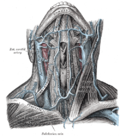Veins (/veɪn/) are blood vessels in the circulatory system of humans and most other animals that carry blood towards the heart. Most veins carry deoxygenated...
49 KB (6,218 words) - 14:22, 9 October 2024
The jugular veins are veins that take blood from the head back to the heart via the superior vena cava. The internal jugular vein descends next to the...
6 KB (676 words) - 23:03, 18 February 2024
In human anatomy, the cephalic vein (also called the antecubital vein) is a superficial vein in the arm. It originates from the radial end of the dorsal...
5 KB (552 words) - 18:11, 9 September 2024
The portal vein or hepatic portal vein (HPV) is a blood vessel that carries blood from the gastrointestinal tract, gallbladder, pancreas and spleen to...
14 KB (1,383 words) - 19:30, 22 September 2024
fibular veins (also known as peroneal veins) are accompanying veins (venae comitantes) of the fibular artery. The fibular veins are deep veins that help...
2 KB (115 words) - 15:36, 8 May 2024
Varicose veins, also known as varicoses, are a medical condition in which superficial veins become enlarged and twisted. Although usually just a cosmetic...
43 KB (4,750 words) - 07:00, 26 October 2024
The basilic vein is a large superficial vein of the upper limb that helps drain parts of the hand and forearm. It originates on the medial (ulnar) side...
5 KB (485 words) - 06:30, 24 August 2024
In human male anatomy, the dorsal veins of the penis are blood vessels that drain the shaft (corpora cavernosa, corpus spongiosum), the skin and the glans...
6 KB (597 words) - 20:52, 1 May 2024
pulmonary veins are the veins that transfer oxygenated blood from the lungs to the heart. The largest pulmonary veins are the four main pulmonary veins, two...
9 KB (936 words) - 16:24, 23 August 2024









